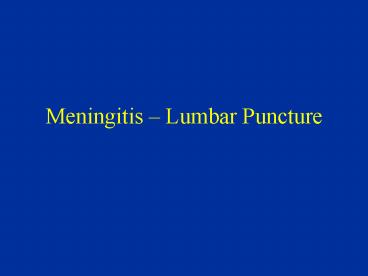Meningitis Lumbar Puncture - PowerPoint PPT Presentation
1 / 19
Title: Meningitis Lumbar Puncture
1
Meningitis Lumbar Puncture
2
Objectives
- Signs of meningitis how good are they?
- Who needs an LP considering the evidence
- Interpreting LP results
- Absolute values
- Before / After antibiotics
3
Causes of childhood acute bacterial meningitis.
- In children aged gt 1 month two pathogens
predominate in unvaccinated populations usually
accounting for gt80 of cases outside the
meningitis belt - Strep. Pneumoniae
- H. influenzae
- In children lt 1month the range of pathogens is
wider with common ones being - Group B Streptococcus
- E.coli
- Klebsiella spp.
4
Outcome of childhood acute bacterial meningitis
- Death
- 30 fatality unless meningococci are a prevalent
cause when mortality is a little lower.
5
Outcome of childhood acute bacterial meningitis
- Death 30
- Severe Handicap 25-30
- Hemiplegia
- Blindness
- Deafness
- Severe Learning Difficulty
- Severe behavioural disturbances
- Severe Epilepsy.
6
Can we do better with hospital care?
- Steroids?
- The inflammation taking place around the brain
causes damage. - Fluid management?
- Restrict fluids to reduce brain oedema
- New antibiotics?
- Ceftriaxone?
7
Can we do better with hospital care?
- Steroids?
- No good evidence that they reduce deaths.
- Fluid management?
- Fluid restriction may do more harm than good
- New antibiotics?
- Ceftriaxone there is NO good evidence that such
antibiotics reduce deaths (yet)
8
CNS - acute infectious disease
Abscess / TB
Cerebral Malaria
Encephalitis
Acute Bacterial Meningitis
Any severe illness causing respiratory or
circulatory failure
9
Who has bacterial meningitis and who needs an LP?
consider 100 cases of meningitis
10
So what is a sensible rule for LP?
- At a minimum, if you want to avoid missing
meningitis (and deaths and handicap from it), and
avoid wasting antibiotics, at least LP those with
history of fever and one of - Bulging fontanelle
- Stiff neck
- Fits if age lt6 months or gt 6 yrs
- Partial or focal fits
- Reduced consciousness
11
Value of LP findings Acute bacterial meningitis.
All the true acute bacterial meningitis cases
12
Bedside assessment alone is very helpful.
75 of acute bacterial meningitis cases can be
detected by examining for CSF cloudiness or
turbidity at the bedside.
13
CSF Cloudiness / Turbidity
A simple test of CSF turbidity is to see if
normal print can be read easily through the
sample CSF should be crystal clear. Cloudiness
usually appears at CSF WBC counts gt 200x106 Wbc
per L
14
CSF culture is great but if it is not available a
microscope will provide nearly all you need to
know.
82 of acute bacterial meningitis cases can be
detected by either turbidity or a CSF white cell
count and using a cut-off of gt50 Wbc per µL. (gt50
x 106 Wbc per L)
15
CSF microscopy, blood and CSF glucose measures
are highly sensitive.
96 of acute bacterial meningitis cases can be
detected by turbidity, a CSF white cell count of
gt50 Wbc per µL (gt50 x 106 Wbc per L) or a CSF
glucose to Blood glucose ratio lt0.1
Books suggest a ratio of 0.6, this is much too
high to be useful
16
LP changes after antibiotics.
- Prior antibiotic use reduces the sensitivity of
CSF gram stain by 20 and CSF culture by 30. - It takes 24-36 hours of therapy before gt90 of
CSF cultures will be sterile. - It takes 2-3 days of therapy to change the WBC
cell count of CSF in true bacterial meningitis. - Prior treatment is no excuse for not doing an LP!
17
But the lab needs.
- Specimens before treatment ideally
- CSF must be processed within 1 hour of collection
- CSF cannot be put in a fridge
- Only put CSF in an incubator if the temperature
is lt 150C and it cannot be taken to the lab
quickly.
18
What do we use for treatment?
- MoH recommends Penicillin Chloramphenicol
- If you prove meningitis by LP then Ceftriaxone is
a very reasonable alternative.but you should
have an LP result.
19
Summary
- Meningitis is suspected clinically but confirmed
by LP - Children will die and suffer disability because
clinicians do not do an LP blaming the lab is
no excuse. - If clinicians and lab staff work together acute
bacterial meningitis can be accurately diagnosed.































